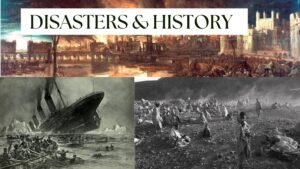
Histories Greatest Disasters by Human Create
Explore the most harrowing human-caused disasters in history, from the Titanic sinking to the Chernobyl meltdown, and uncover the lessons they hold for the future.
Human actions have led to some of the most catastrophic events in history, forever changing the course of lives and landscapes. This article embarks on a journey through time to unveil histories greatest disasters orchestrated by human hands, shedding light on the profound impacts and the lessons learned in their wake.
Histories Greatest Disasters by Human Create
- Introduction to Human-Caused Disasters
- The Titanic Tragedy: A Collision of Errors
- Chernobyl Disaster: Nuclear Nightmare Unleashed
- Bhopal Gas Tragedy: Night of the Toxic Cloud
- Exxon Valdez Oil Spill: Environmental Catastrophe at Sea
- Hiroshima and Nagasaki: The Atomic Agony
- Great Chinese Famine: Tragic Consequence of The Great Leap Forward
- Deepwater Horizon Oil Spill: Deep Sea Disaster
- Rana Plaza Collapse: Tragedy in Textile Industry
- Armenian Genocide: Early 20th Century Atrocity
- Dust Bowl: The Great American Environmental Disaster
- Halifax Explosion: World War I Calamity
- Love Canal Chemical Waste Crisis: Hidden Dangers Underground
- Global Financial Crisis 2008: Economic Turmoil Unfolded
- Amazon Rainforest Deforestation: A Slow-Moving Disaster
Introduction to Human-Caused Disasters
Disasters caused by human actions have shaped the course of history, altering the fabric of societies and the natural environment. From industrial accidents to environmental negligence and acts of war, the repercussions of these calamities have been far-reaching and devastating.
Histories Greatest Disasters by Human Create
The Titanic Tragedy: A Collision of Errors
The Titanic Tragedy, a collision of errors and overconfidence, led to one of history’s deadliest maritime disasters. Ignoring iceberg warnings, the ‘unsinkable’ ship met its doom in the Atlantic, causing over 1,500 deaths. This catastrophic loss underscored the fatal consequences of human error and technological failings, prompting a sea change in safety protocols. The Titanic’s story remains a harrowing reminder of the high stakes of negligence and the preciousness of life.
Chernobyl Disaster: Nuclear Nightmare Unleashed
The Chernobyl disaster, a catastrophic blend of human error and system failure, unleashed a radioactive nightmare, claiming thousands of lives and causing widespread environmental damage. Mismanagement and design flaws led to the reactor explosion, highlighting the dire consequences of overlooking safety protocols. The tragedy at Chernobyl serves as a grim reminder of the potential human cost of nuclear power mishaps and the enduring impact of such disasters on people and the planet.
Bhopal Gas Tragedy: Night of the Toxic Cloud
In Bhopal, India, a deadly gas leak at a pesticide plant exposed over half a million people to toxic chemicals, leading to thousands of deaths and ongoing health issues. This disaster highlighted the dire consequences of industrial negligence.The Bhopal gas tragedy, a devastating event of human and technical failings, unleashed a toxic gas cloud, leading to thousands of deaths and continued suffering for many. Negligence in safety measures and lack of emergency response preparedness at the Union Carbide plant resulted in one of the worst industrial disasters in history. This tragedy highlights the catastrophic consequences of ignoring industrial risks and the urgent need for stringent safety and environmental regulations.
Exxon Valdez Oil Spill: Environmental Catastrophe at Sea
The Exxon Valdez oil spill, a disaster born of human error and oversight, caused immense ecological damage and economic loss. Striking a reef in Prince William Sound, Alaska, it spilled millions of gallons of crude oil, devastating wildlife and local livelihoods. This incident not only led to extensive environmental destruction but also marked a turning point in oil spill prevention and response, underscoring the critical need for stringent operational and safety protocols in the industry.
Hiroshima and Nagasaki: The Atomic Agony
The atomic bombings of Hiroshima and Nagasaki, resulting from strategic wartime decisions, led to unprecedented human loss and suffering, with hundreds of thousands dead and cities obliterated. These events exposed the horrific power of nuclear weapons and the devastating impact of warfare errors. The bombings serve as a somber reminder of the tragic consequences of military action and the enduring need for peace and disarmament to prevent such catastrophes in the future.
Great Chinese Famine: Tragic Consequence of The Great Leap Forward
The Great Chinese Famine, a tragic consequence of policy failures and environmental mismanagement during the Great Leap Forward, resulted in the deaths of millions. Misguided agricultural reforms and governmental errors led to widespread hunger and suffering, marking one of the deadliest famines in history. This dark period underscores the catastrophic impact of political decisions on human life and the importance of sound, evidence-based policies to prevent such immense human loss.
Deepwater Horizon Oil Spill: Deep Sea Disaster
he Deepwater Horizon oil spill, a disaster marked by oversight and safety failures, led to extensive environmental damage and loss of life. The explosion on the drilling rig caused millions of barrels of oil to spill into the Gulf of Mexico, devastating marine life and local economies. This calamity highlighted the risks of deepwater drilling and the urgent need for robust safety measures and disaster preparedness in the oil industry to prevent future tragedies.
Rana Plaza Collapse: Tragedy in Textile Industry
The Rana Plaza collapse, a stark example of industrial negligence and structural failure, led to over 1,100 deaths and thousands injured, making it one of the deadliest garment factory accidents in history. Ignored warnings and substandard building conditions culminated in this tragedy, exposing the dire consequences of compromising safety for profit. The disaster underscored the urgent need for stringent building codes, ethical labor practices, and corporate accountability in the global fashion industry.
Armenian Genocide: Early 20th Century Atrocity
The Armenian Genocide, a catastrophic event of systematic extermination, resulted in the deaths of approximately 1.5 million Armenians. Orchestrated by the Ottoman Empire during World War I, this atrocity was a consequence of ethnic hatred and flawed policies. The genocide inflicted immense human loss and suffering, highlighting the destructive power of state-sponsored violence and the importance of international intervention and recognition in preventing such crimes against humanity.
Dust Bowl: The Great American Environmental Disaster
The Dust Bowl, a severe environmental disaster in the 1930s American Great Plains, resulted from a combination of drought and poor agricultural practices. Mismanagement of land and failure to apply sustainable farming methods led to widespread soil erosion and dust storms, causing crop failures, economic devastation, and loss of life. This ecological catastrophe highlighted the critical need for environmental stewardship and sustainable land management practices to prevent such environmental and human tragedies.
Halifax Explosion: World War I Calamity
The Halifax Explosion, one of the largest non-nuclear explosions in history, occurred during World War I, devastating the city and resulting in over 2,000 deaths and thousands injured. A collision between a munitions ship and a cargo vessel in Halifax Harbour triggered the massive blast, exacerbated by communication failures and mismanagement. This tragic event underscores the dangers of handling hazardous materials and the importance of rigorous safety protocols and emergency preparedness in preventing such disasters.
Love Canal Chemical Waste Crisis: Hidden Dangers Underground
The Love Canal crisis, a toxic disaster in Niagara Falls, New York, emerged from the negligent disposal of chemical waste and inadequate urban planning. Buried toxic substances leaked into neighborhoods, causing health crises and environmental damage. This catastrophe led to widespread illness and loss of life, highlighting the grave consequences of industrial waste mismanagement and the critical need for stringent environmental regulations and responsible waste handling to safeguard public health and ecosystems.
Global Financial Crisis 2008: Economic Turmoil Unfolded
The 2008 Global Financial Crisis, triggered by a collapse in the housing market and financial system errors, led to widespread economic turmoil and significant loss of life through increased suicide rates and reduced healthcare access. Mismanagement in financial sectors, risky lending practices, and regulatory failures culminated in a severe recession, job losses, and financial despair for millions globally. This crisis underscores the importance of financial stability, regulatory oversight, and the human cost of economic collapse.
Amazon Rainforest Deforestation: A Slow-Moving Disaster
The deforestation of the Amazon Rainforest, driven by agricultural expansion, illegal logging, and flawed policies, is a slow-moving disaster causing ecological collapse, loss of biodiversity, and displacement of indigenous communities. This environmental degradation leads to habitat destruction, contributing to global warming and loss of life through climate-related disasters. The ongoing deforestation of the Amazon underscores the urgent need for sustainable land management, conservation efforts, and global cooperation to prevent further loss and damage.
Human Caused Disasters
Histories Greatest Disasters by Human Create
Great Tragedies
https://uniquesaga.com/the-top-25-undefeated-military-leaders-of-all-time/
https://www.livescience.com/worlds-biggest-man-made-disasters





